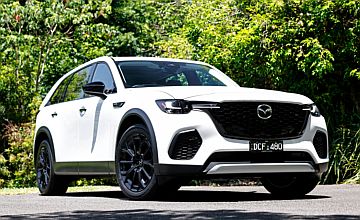OptionsCar reviews - Mazda - CX70Mazda modelsOverviewWe like Punchy six-cylinder diesel and petrol engines; heaps of standard kit including surround-view camera; upmarket interior vibe; better handling than other big Mazda SUVs; around $10K cheaper than CX-90 Room for improvement Transmission has some quirks; it is a massive vehicle to have only five seats; no spare wheel; wireless phone charger repeatedly failed Big CX-70 five-seater SUV is a niche offering, but arguably Mazda’s most enticing18 Nov 2024 Overview
THIS is one of the most intriguing models from Mazda in a while – it’s the CX-70, a big SUV with five seats that comes with a limited number of choices and isn’t expected to sell in big numbers.
That’s despite the fact the CX-70 – which is, in essence, a CX-90 with two fewer seats – is, in my opinion, the most convincing model in the new-gen Mazda Large SUV Platform rollout.
The CX-70 line-up kicks off with the GT grade at $75,970 +ORCs for the G50e petrol model, while the GT D50e diesel adds a $2000 premium ($77,970 +ORCs).
It has 21-inch black alloy wheels, adaptive LED headlights, a panoramic sunroof, electric tailgate, leather upholstery, leather heated steering wheel with electric adjustment, heated front seats with electric adjustment, heated outboard rear seats, a 12.3-inch infotainment screen with wireless and wired Apple CarPlay and Android Auto, DAB+ digital radio, satellite navigation, a 12.3-inch digital instrument cluster, head-up display, 12-speaker Bose sound system, and tri-zone climate control.
If you prefer some extra spec and tech, the Azami G50e will set you back $82,970 +ORCs, while the D50e diesel lists at $84,970 +ORCs. It adds body-coloured wheel-arches, lower cladding and door handles, Nappa leather upholstery, ventilated front seats, ambient lighting, a frameless interior mirror and a personalisation system for the driver’s seat.
Want more still? The optional SP package is $3500 for the Azami and has tan Nappa leather upholstery, a suede dashboard panel and a two-tone steering wheel.
The cabin is basically identical to the donor CX-90 model, with a classy design, good usability, and reasonably simple controls for the media system and driver info screen. There’s also good comfort and adjustability for adults.
The second row is adjustable for comfort, too, despite the fact there’s no third-row to make accommodations for. Even so, rear riders can recline and slide if they wish, and there are ISOFIX points in the window seats as well as top-tethers for all rear spots, too.
Boot space is, as you’d expect, very good without a third row taking up space. There’s 598 litres of cargo capacity to the parcel cover, including some underfloor storage, too. However, despite there being room for one, there is no spare wheel, which could trouble some customers.
The G40e has a 3.3-litre inline six-cylinder petrol with 209kW and 450Nm, and fuel consumption rated at 8.1 litres per 100km. Choose the D50e and you also get a 3.3-litre in-line six with 187kW and 550Nm, and fuel use of 5.3L/100km. These models have 74-litre fuel tanks. There is no PHEV on offer in the CX-70 (or CX-90 for that matter).
Towing capacity for the petrol and diesel models is up to 2500kg for a braked trailer, 750kg for unbraked, and all have a 150kg ball limit. Be mindful of the payload limit for this model, though, it’s just over 500kg, meaning those planning to load up the family and tow a trailer will need to do the maths first.
There’s no ANCAP rating yet for the CX-70 line-up, and the CX-90 it’s based on hasn’t been rated either.
However, there is a long list of gear including autonomous emergency braking with pedestrian, cyclist and junction detection, lane keeping assistance, blind-spot monitoring, front and rear cross-traffic alert, a surround-view camera system, front and rear parking sensors, a speed sign recognition system and a driver monitoring camera, too.
Airbags? Eight; including dual front, front side, front centre, driver’s knee and curtain coverage for both rows.
Mazda Australia offers a five-year/unlimited-kilometre warranty for the CX-70, and five years’ roadside assistance is included at no cost, too. There’s a seven-year capped-price servicing program, but the costs are relatively high: $666 on average for petrol, and $708 for diesel.
In this instance, both powertrains have 12 month/15,000km service intervals.
Driving impressions
The CX-70 has the same widebody stance as the CX-90, with a broader track width than the related CX-60 and CX-80 models.
That results in a more comfortable and planted feeling on the road, and despite the fact Mazda claims there are no suspension changes for this five-seat model, it feels far more composed and controlled than the seven-seat version, based on my initial impressions.
I’m not saying it’s the most comfortable large SUV – it isn’t, and if you’re looking for a more cossetting ride, check out a Volkswagen Touareg – but the CX-70 feels the more impressive option in the Mazda large SUV line-up because it manages to blend handling and ride comfort better than the three other choices in the line-up.
As with the other models, though, the transmission can exhibit some strange behaviours, feeling a touch clunky when cold and somewhat hesitant in stop-start situations.
But the engines? Cracking, when you get them moving. There’s ample power from the petrol, which happily sings up to about 7000rpm, while the diesel’s lower-rev urge helps propel it in a more effortless fashion. And both sound pretty good, too.
As with other high-spec CXs there is a 48-volt mild-hybrid system that will cut the engine at times, and there’s regen braking built in, too – and while the brake pedal feel isn’t convincing, the fuel consumption might well help you make your decision.
For reference, I saw 6.5 litres per 100km in the diesel during some mixed and spirited driving, while the petrol was showing 9.8L/100km in similar testing.
 |
OptionsClick to share
|














Facebook Twitter Instagram